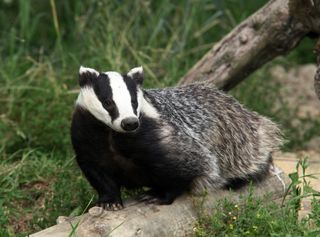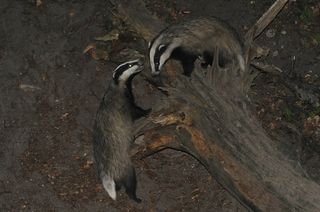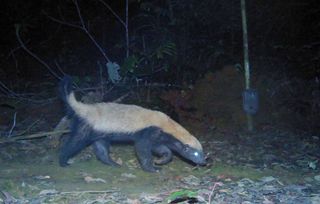Facts About Badgers

Badgers are small mammals with flat, wedge-shaped bodies, broad feet with long claws and coarse hair that can be black, brown, gold or white. They are related to ferrets, minks, otters, weasels and wolverines. All of these animals are members of Mustelidae, the largest family in the order Carnivora.
The classification of badgers is complex. According to Daniel Heath Justice, author of "Badger" (Reaktion Books, 2015), "Categories are under constant revision, rendering the taxonomic accuracy of any study … temporary at best."
Justice acknowledges that there continues to be a debate about which animals should be considered "true badgers." "Scientists generally agree on three species: the Eurasian badger, the Asian hog badger and the North American badger." Including the honey badger in this group is controversial, he wrote, because it is genetically and genealogically distant from the others. However, the honey badger, also called the ratel, is generally still included among "badger-kin."
Classification/taxonomy
According to the Integrated Taxonomic Information System (ITIS), a partnership of several U.S. agencies, a generally accepted taxonomy of badgers is:
Kingdom: Animalia Subkingdom: Bilateria Infrakingdom: Deuterostomia Phylum: Chordata Subphylum: Vertebrata Infraphylum: Gnathostomata Superclass: Tetrapoda Class: Mammalia Subclass: Theria Infraclass: Eutheria Order: Carnivora Suborder: Caniformia Family: Mustelidae Subfamily: Mustelinae* Genera & species:
- Arctoryx collaris — Hog badger (with six subspecies)
- Meles anakuma — Japanese badger
- Meles leucurus — Asian badger (with six subspecies)
- Meles meles — European (or Eurasian) badger (with eight subspecies)
- Mellivora capensis — Honey badger (with 12 subspecies)
- Taxidea taxus — American badger (with five subspecies)
*Some taxonomies list subfamilies as Melinae (European and Asian badgers), Mellivorinae (honey badgers) and Taxidiinae (American badgers).

Size
Badgers can grow up to 20 to 34 inches (51 to 86 centimeters) long from head to tail. The tail adds an additional 4 to 6 inches (10 to 15 cm) to its length. Badgers weigh between 9 and 39 pounds (4 to 18 kilograms).
Habitat
Badgers prefer dry, open grasslands, though they are very adaptable. Some also live in woods, quarries, hedgerows, sea cliffs and moorland. American badgers are typically found in the Great Plains region of North America. They can also be found in the western United States, central western Canadian provinces and in the mountainous areas of Mexico, according to the Animal Diversity Web (ADW) at the University of Michigan.
Honey badgers are found in southern Africa; hog badgers live primarily in Southeast Asia, India and Sumatra. The Asian badger extends across Russia and into China and Eastern Europe. The European, or Eurasian, badger spans from Ireland and Spain all the way to eastern Russia, China and Japan, according to ADW.
Badgers are also found in large numbers in the United Kingdom. Government officials have taken steps to “cull” the population to prevent the spread of tuberculosis from badgers to cattle.
Habits
Badgers are nocturnal, meaning they are most active at night and sleep during the day.
Badgers have strong limbs and sharp claws that help them dig burrows and find food underground. They make their homes by digging tunnels and caves and use grass and leaves for bedding. A badger’s home is called a sett. Setts have a special chamber reserved as the bathroom because badgers are clean creatures, according to the Somerset Wildlife Trust.
Many badger species are very social creatures and live in groups called a cete or clan. A clan shares territory and setts. Setts can be centuries old and are used by many generations of badgers. One sett can be 22 to 109 yards (20 to 100 meters) or more long, according to the Somerset Wildlife Trust.

Diet
Most badgers are omnivores, which means they eat both plants and meat. Typically, though, they mainly consume earthworms and the larvae of daddy long legs, according to the Nottinghamshire Wildlife Trust. Some other foods badgers enjoy include slugs, small mammals, snails, bird eggs and fruit.
The honey badger is a carnivore and will eat snakes, jackals, foxes, and even crocodiles, according to BioWeb, a website produced at the University of Wisconsin. It also eats smaller animals, such as insects and larvae. It will also hunt down beehives to get to the honey, hence its common name and scientific name — Mellivora means "honey eater."
Offspring
Though badgers mate any time they feel like it, they only have one litter per year due to delayed implantation. Badgers give birth in mid- to late winter between birth to between January and March. One to five babies are born at one time in the underground chambers. Baby badgers, like baby bears, are called cubs. Cubs remain in the birthing chamber until they are about eight weeks old, according to the Nottinghamshire Wildlife Trust.
Conservation status
According to the International Union for Conservation of Nature (IUCN), most badgers are not endangered or threatened. The American badger, for example, has a population of several hundred thousand in the United States. The hog badger is listed as near threatened because of a population decline of less than 30 percent over three generations. It is severely threatened in some areas, such as Laos, Vietnam, China and Myanmar.
'Honey badger don't care …'
Honey badgers became popular due to a YouTube video with a humorous voiceover. Honey badgers are known for their ferocity. Some fun facts about honey badgers:
- They are called ratels because of the rattling sound they make when they are being attacked.
- They have a resistance to snake venom.
- When attacking beehives, they release a fume that spreads throughout the hive.
- When attacking large animals, such as lions, they go for the scrotum.
Other facts
- Badgers don’t usually hibernate, but sometimes they will sleep for a few days or weeks in their dens during the coldest part of winter.
- The dachshund was bred to hunt badgers. Dachshund in German means "badger hound."
- The badger is the state animal of Wisconsin.
- Badgers typically live around 10 years.
- While many badgers are social, the American badger is not, and spends most of its time alone.
Additional resources
Sign up for the Live Science daily newsletter now
Get the world’s most fascinating discoveries delivered straight to your inbox.

